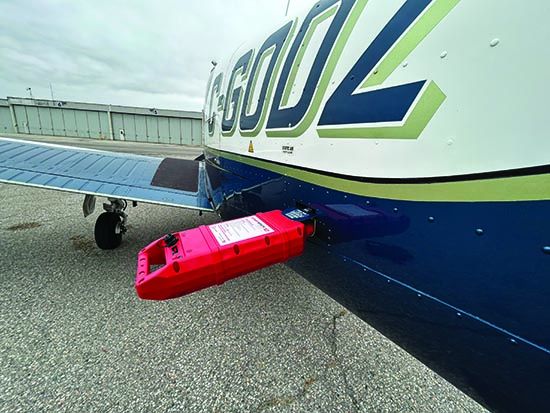Upgrading to electronic flight displays and a data-hungry GPS navigator? Add a reliable GPU (ground power unit) to the budget. That’s because you’ll have the master switch on for extended periods while loading nav data, uploading flight plans and fetching engine trend data. If those chores don’t kill an otherwise healthy battery, messing around with the new avionics during a ground training session will.
The good news is that there are good ground power accessories for feeding stable and regulated voltage to the electrical bus, and also for starting the engine. Here are some top picks, but first an overview of the tech.
GPU 101
There are two types of GPUs: small portables designed to power the aircraft’s avionics and higher-output GPUs for engine starts. Historically, GPUs designed to start the engine have diesel engines running a generator to output DC voltage. You’ve seen or used them in the turbine world for ground starts or to run the aircraft’s air conditioning. With the advent of lithium batteries, engine-start GPUs have shrunk in size and weight, becoming conveniently portable. Some weigh as little as 10 pounds—tossable in the baggage compartment. These are a reassuring backstop when traveling because you never know when you’ll flatten the battery after leaving the master and rotating beacon on when parked in the middle of nowhere, with no FBO support. Aside from starting, the use case for GPUs focuses on avionics demonstration and testing, database and firmware updates, flight planning and cockpit procedures training. There’s also maintenance and troubleshooting, powered preflight inspections and battery top-off.
Desirable aviation GPUs share the same characteristics, delivering continuous 14- or 28-volt DC power output with a specific amount of amps. They’re built from high-quality components to ensure high-quality power output, plus noise reduction circuitry so there’s no comm radio interference (you might use a GPU when radioing for clearance). There should be over- and under-voltage protection and an amperage and voltage meter are desirable features.
Weight and size will vary based upon a variety of factors, typically starting as little as six pounds to the extreme size of requiring a small truck to tow the GPU to the aircraft (think turbine aircraft). Some avionics GPUs have removable cables, both for the AC power connection but also for connecting to the aircraft. When shopping for a GPU, you should understand your requirements, beginning with your aircraft make and model and voltage requirements, but also the use of the GPU, e.g., aircraft start versus running your avionics. Start with the POH.
If your 14-volt aircraft is experimental and does not have an external power receptacle, a wiring kit and matching output cable might be available at additional cost. Contact the GPU manufacturer for assistance in selecting the correct GPU and cabling accessories.
HOOK UP – WITH CAUTION
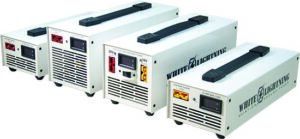
Manufacturer’s instructions aside, you want to be familiar with the basics. For the most part, GA aircraft external power connections come in two flavors: an AN2551 three-pin oval connector (sometimes referred to as a NATO connector), and a two-pin round Piper 12- or 24-volt connector (a 11041 socket on the aircraft). Pipers use a round connector that ensures that you cannot plug it in backward and reverse polarize the connection (creating a lot of sparks when you energize the GPU). Cessna and others use an AN2551 flat oval connector, which is keyed (two large pins and one small pin) to ensure that the connector cannot be plugged in backwards.
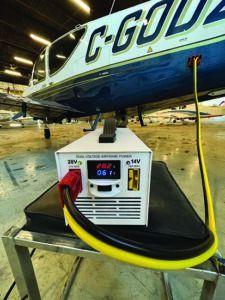
If there’s any doubt, it’s worth leaning on your maintenance shop for some advice on how to use the GPU without frying your aircraft’s electrical system. Plugging a 28-volt GPU into a 14-volt aircraft will create some interesting YouTube content. Surprisingly, the industry has not standardized on different GPU power plugs for different aircraft voltages.
Engine starts using a GPU will vary between aircraft type and you should follow the POH to the letter. And, some aircraft models are set up so that when a GPU is attached (and powered on), the instrument panel on the aircraft will be powered without the need for the battery master switch to be turned on. A good practice is to plug the GPU into the aircraft with the power to the GPU turned off, to prevent electrical arcing while the power connector is attached to the aircraft. Before the GPU is connected to the aircraft, confirm that the GPU is set to the appropriate voltage for your aircraft. Once you’ve double-checked GPU voltage and aircraft voltage, plug the GPU into a 110-volt AC outlet and turn the GPU on. Most GPUs display voltage and amps. You should see 14 or 28 volts, depending on your aircraft.
Some aircraft have a solenoid designed to provide power to the panel, without the battery master turned on. If your aircraft is designed this way, once the GPU is attached to the aircraft and supplying power, the aircraft’s electrically driven instruments and avionics will power on. If not, as is the case with the Rockwell that I fly, you will have to turn on the battery master. You can then turn on your avionics master switch and aircraft lighting.
Connecting a GPU to some aircraft may automatically energize certain airframe systems (like motors for air conditioning or hydraulics) that could cause an overload condition. A sustained overload will generally cause the GPU to self-protect and shut down, requiring disconnection from the aircraft and cycling the power switch to reset its internal protection. Help avoid an overload by pulling the circuit breakers that control the devices with the most current draw.
AUDIO AUTHORITY
Audio Authority of Lexington, Kentucky, was founded in 1976 and has been manufacturing aircraft GPUs since 2004 from its Lexington plant. Audio Authority has four aviation product lines (while also manufacture automotive audio technologies): Enhanced Flight GPU, the White Lightning GPU, aviation-grade power cables and the BatteryMINDer—an aircraft battery smart charger.
The Enhanced Flight GPU is available in four models and can be purchased with an optional integrated BatteryMINDer. Enhanced Flight has two core models, 28-volt and either 35- or 70-amp. I like that the labelling on the Enhanced Flight GPU clearly indicates that it is a 28-volt GPU. The 2800 Series GPUs achieve 89 percent electrical efficiency to provide up to 2000W of power. Its switching-mode power modules are designed to provide stable, noise-free power from a 90- to 230-volt AC outlet.
The 2800 Series GPU body has a useful design with dual, removable cord/tool caddies, which are perfect for storing the GPU’s cables. The GPU weights 17.8 pounds without cables. The 35-amp and 70-amp models cost $995 and $1,445 respectively. Adding a BatteryMINDer to the GPU adds an additional $350.
Audio Authority’s White Lightning line of GPUs are smaller and less expensive GPUs than the premium Enhanced Flight GPUs, with plenty of versions—six different ones: There’s the $475 35-amp 14-volt model targeted at experimental aircraft, a $525 35-amp 14-volt model with 3-pin oval connector (for Cessna and others), a $525 35-amp 14-volt with round Piper plug, a $1025 35-amp 12- and 24-volt model with 3-pin oval plug, a $645 27-amp 24/28-volt unit with 3-pin oval plug and a $995 50-amp 28-volt unit with 3-pin oval plug.
White Lightning GPUs include an auto shutdown safety timer, USB mobile device charger and six-foot power cables. The experimental aircraft model (M1435-EXP) ships with a six-foot output cable with yellow SB50 plugs on each end, used to connect the GPU to the aircraft. An airframe interface kit containing another yellow SB50 plug, contact plugs and a protective cover is also included with the product. Homebuilders generally mount this plug near the battery solenoid or airframe ground (not directly to the battery) and wire a fused connection to the plug. This provides a convenient connection point between the aircraft and the GPU.
The White Lightning GPUs are not designed for long-term battery charging. They have no circuitry for monitoring the battery’s state of charge or determining the precise charging voltage for various battery conditions and ambient temperature. However, for short periods of time, the GPU’s output can be used to “top-off” the charge of a battery that is not severely discharged. This is particularly useful during a powered preflight without depleting the starting battery. The White Lightning GPUs have a two-color LED status indicator. In normal operations, the LED will be a solid green. If the GPU is shutting down (due to overheating, as an example), the LED will flash green. If there is a fault condition, the LED will flash red.
The White Lightning GPUs have cable ports, with no cables hardwired to the GPU. I really like this feature because it allows the cables to be stored in a separate bag for transportation, helping to eliminate “cable spaghetti.” Audio Authority sells the 3-pin oval, round Piper and experimental aircraft cables separately, allowing you to reuse the GPU on a variety of aircraft. Plus the company offers a variety of useful accessories for the GPUs, and there’s a prototype carry bag in development, which may be offered as a future option.
I really like the new White Lightning dual-voltage M1428-DV GPU. To safeguard supplying 28 volts to a 14-volt aircraft, the M1428-DV has two electrical ports (one for 14 volts and one for 28 volts), controlled by a switch on the front panel. Two SB50 connectors are used on the GPU and are color coded to voltage (red for 28 volts and yellow for 14 volts). The M1428-DV ships with two airframe cables (six feet long), one with a yellow SB50 connector and one with a red SB50 connector. The yellow and red GPU connectors are keyed so that a yellow connector cannot be attached to a red port on the GPU. Both cables have AN2551 3-pin oval plugs that connect to the aircraft. If a six-foot cable is not long enough, an SB50 12/14-volt extension cable can be ordered (Model 802-864, $25). As a reminder, triple-check the connections and voltage settings to ensure that you don’t get a mismatch. If your aircraft is 28 volts, the aircraft GPU cable is attached to the 28-volt connector, but if the M1428-DV switch is set to 14 volts, the GPU voltage display will read 14 and no voltage will be supplied to the aircraft—a great safety feature to ensure that you get things right.
A really cool feature on the White Lightning GPUs is an automatic shutdown timer, located on the back of the chassis. You turn the 10-position rotary switch to the desired duration using a small screwdriver. To disable the automatic shutoff feature, simply set the rotary switch to zero.
I also like that the White Lightning units are made with high-quality aerospace-grade components, plus the cables are torch soldered with heavy-duty copper contacts and silver plating. The wire is up to 0 AWG wire, which delivers 50 percent more power and up to 1600 amps (peak). Audio Authority has a $163 aircraft jumper cable (model 802-689B) designed to use your car’s battery to jump start your aircraft. The cable supports 500 amps (600-amp peak) and is 20 feet long with four-gauge wire and PVC-coated with insulated copper jaw clamps. Audio Authority GPUs can be purchased from Aircraft Spruce and Sporty’s and have a one-year warranty. The company has new models on the drawing board including a higher amperage unit to replace the Enhanced Flight Model 2870A. Visit www.audioauthority.com.
START PAC
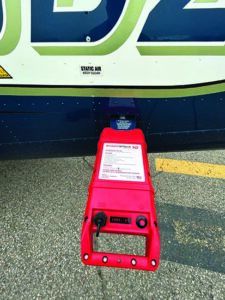
Otherwise known as Start Pac, Rotorcraft Enterprises has been manufacturing GPUs since 1997, founded by Jim and Judith Wurth. Jim was a retired Eastern Airlines pilot who had transitioned to flying helicopters, Jim had a situation where his MD500 helicopter (and battery) had become cold soaked overnight and he was unable to start the engine until the battery warmed up in the afternoon. As an engineer, he designed version 0 of Start Pac, for his personal use. Judith recognized the business opportunity and one year later they had built 11 Start Pacs, selling them to their friends. Fast forward to 2022, and Start Pac has sold over 50,000 GPUs and has 22,000 customers, operating in over 100 countries. You might recognize Start Pac products from their signature yellow-colored GPUs. The newer lithium battery-powered portable starting units are blue, while the lead-acid powered portable units are yellow.
GPU battery life is cycle, temperature and engine dependent, but with normal usage the lead acid users tend to get from three to six years before the GPU requires battery replacement. Start Pac can refurbish pretty much all of its GPUs, but they have a quick-change design for one-minute battery changes in the field—no tools or training required.
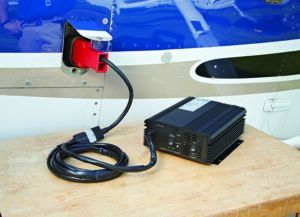
Start Pac’s GPU aircraft cables detach from the 53200, 53300 and 53400 models only. The smaller GPUs are hard-wired in. When ordering a GPU, you can specify the type of connector (e.g., NATO or Piper) to be supplied. The company makes all GPUs and cabling in-house, and Start Pac battery-powered GPUs come with a charger and aircraft adapter cable kit. Start Pac recommends that the Start Pac Micro (lead acid) and Start Pac One (lithium) not be used for avionics or compressor washes to prevent deep discharge damage to the GPU. It also recommends that an engine start with the portable GPUs be conducted at least once per month to exercise the battery chemistry.
Priced at $2644, the 14-pound, 28-volt Start Pac Pro delivers 1800 peak amps. In certain aircraft where the generator can back-charge to a GPU, the Start Pac can be recharged in the field without an AC source.
Start Pac has several 110/220V-powered GPUs designed to provide power for avionics work and training. The $695 model 53050 is a 12/14-volt GPU (factory set to 14.2 volts) with a maximum output of 50 amps, has a continuous cooling fan and weighs eight pounds. The 53025 is a 24/28-volt GPU (factory set to 28.5) with a maximum output of 25 amps, weighs eight pounds and is also priced at $695. The battery-powered Start Pac Micro is $1095 and the Start Pac One and Start Pac Pro are priced at $2737.
Start Pac products have a one- year warranty. However, the company sees batteries as consumable items that can be damaged from misuse and are not covered by the warranty. The company does have a lifetime trade-in program for any older Start Pac GPU toward a similar or greater valued unit. Start Pac is distributed by several distributors including Aircraft Spruce. Visit www.startpac.com.

STARTSTICK
Founded in 2014, Battery Aviation Systems makes the 28-volt StartStick portable GPU product line, with more than 2000 units sold. StartStick is powered by NanoPhosphate lithium iron phosphate cells manufactured by A123 Systems. StartStick has three models, essentially the same, but with different battery capacities and weights. StartStick is designed to plug directly into the aircraft’s GPU NATO port (oval), with no cables required. Unfortunately, there are currently no plans to introduce a 12/14-volt model or a Piper (round) compatible connector.
There are three models to choose from. The $3695 StartStick 10 weighs 10.6 pounds, has a 9.7 Ah capacity and has a 2.8-hour charge time to full. The $4695 StartStick 15 weighs 14.9 pounds, has a 14.7 Ah capacity and has a 4.2-hour charge time to full. Weighing 20.2 pounds, the $5695 StartStick 20 has a 19.4 Ah capacity, with 5.6 hours to a full charge. The time before complete discharge is 29, 44 and 60 minutes, respectively. All three models should deliver more than 1000 charge cycles and between 3000 and 4000 engine starts before they require overhaul. The way I see it, 10 pounds of extra weight in your baggage compartment offsets the hassle of trying to start your aircraft in a remote airport with no services.

StartStick has a sunlight-readable screen that displays several messages, including information about the battery. The product ships with an A/C adapter for charging, a protective ballistic nylon carrying bag and a laminated reference card. The carrying bag has a zippered pouch for the AC adapter, a detachable shoulder strap and tiedown rings.
During winter operations, if StartStick is left in the cold, there is a warmup procedure for temperatures between 0 C and -20 C, using the battery’s own energy to self-heat. For sustained low temperatures or for applications where an engine motoring is not practical, the battery should be warmed indoors.
When I tested StartStick, I was concerned about hanging a 10-pound mass from the Commander’s GPU port. The depth of the connector creates a mechanically balanced connection, which appears on the surface not to put too much strain on the aircraft’s GPU port. The loads on the aircraft’s GPU connector for StartStick 10, 15 and 20 are 7.7, 12.4, 14.9 ft/lbs respectively.
Once attached to the Commander, it automatically turned itself on and began to supply power. Charging the StartStick is a breeze, plus the unit is made well, with a water-resistant charging port equipped with a screw-on cap to resist water. Plus, the AC adapter’s connection will not allow the connector to be attached backward. Charging takes a few hours, with the LED display displaying 100 percent when fully charged. StartStick has a red on/off button—and you want to turn the unit off before detaching it from the aircraft. The LED display will turn off, indicating that the StartStick is off.
StartStick has a two-year limited warranty and is not field serviceable, with a four- to 10-year time before overhaul, which typically costs $1500. Shipping internationally is not a big deal, but will be dependent upon requirements of your specific country. StartStick is available through their distributor and dealer network (including Mid-Continent Instruments and Avionics and Boeing Aviall). Visit www.start-stick.com.
SCHAUER, RED BOX AVIATION
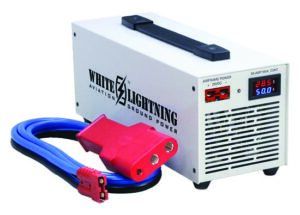
Sporty’s sells two aviation power supply and battery chargers, either 12 or 24 volts, manufactured by Schauer. Both models (JAC2512, 12-volt, 25 amp, and JAC2024H, 24-volt, 20 amp), require a 115/230-volt power outlet. Schauer power supplies have a hardwired cable to the power supply and the cable has an SB50 connector, allowing either a NATO or Piper cable or battery clips to be attached. These power supplies are manufactured in the USA and are simple to use.
Begin with selecting the type of aircraft battery, either Flooded or GEL/AGM. Attach the power supply to the aircraft and turn the power supply on. The power supply has two LEDs on the rear panel, labeled Power and Equalizer. The Power LED will be red when AC power is connected. The Equalizer LED is multicolor: Off, the charger is not connected to the aircraft or the minimum aircraft battery voltage is not sensed; amber, the battery is low and is charging; and green, battery is charging in float mode. Of note, the battery clip pigtail connecter has a built-in fuse. If the fuse blows or is defective, the Equalizer LED will display green, but the aircraft’s battery will not be charged.
While the power supply will charge a battery, it is not a smart trickle charger and is not designed to desulphate batteries (consider buying a product like a BatteryMINDer). When the aircraft’s battery is fully charged, the power supply will switch to a maintenance float voltage. For charging, Schauer recommends connecting the power supply directly to the battery using battery clips, rather than the aircraft’s external power connector. Schauer’s optional adapter with ring terminals provides a permanent connection to the battery. Contact Schauer directly at 513-791-3030 and see it at www.sportys.com.
Red Box Aviation has been manufacturing ground support equipment since 1993, including solid-state GPUs. To help size and select the right GPU, Red Box has a good GPU sizing tool on its website (www.redboxaviation.com/aircraft-search/). The tool is easy to use. Simply select your airframe manufacturer and model, which will display a small table listing all recommended Red Box products. You can click the aircraft, which displays detailed and resourceful information about it. Red Box has a wide variety of continuous power GPUs ranging from 25 to 600 amps.
Unfortunately, we reached out to the company for samples and for more information as we did with the others, but they didn’t respond. That’s unfortunate because to that end, we can’t make a recommendation. If you have experience with a Red Box GPU—including the company’s support quality—we want to know about it.
CONCLUSION
Portable GPUs are worth their weight in gold, especially if you’re stuck at a remote airport lacking services. You know, the day that you left your battery master and beacon on, while offsite at a meeting or a $100 hamburger.
Battery Aviation Systems’ StartStick hits all the checkmarks, and I really like the thought and little extras put into the product. Starting at $3700, they’re not inexpensive, but could pay for themselves quickly, especially for flight school ops, where time and dispatch reliability is money. The downside is they only work on 28-volt aircraft.
For owners who only want a GPU to run the aircraft’s electrical systems for avionics training and troubleshooting purposes, Audio Authority’s White Lightning products easily get the nod. They’re high-quality and cost-effective GPUs that you can use regularly, especially during the winter months for preflighting the aircraft’s lighting or updating databases, while conserving precious battery power. I like the versatility of the White Lightning line, with the ability to store the cables separately from the GPU and adding other connector types later. It’s one of those products that you only buy once.
I’m curious when GPU manufacturers will add Bluetooth connectivity, electronics and apps to provide more insight into the health of the aircraft’s battery, offering a proactive battery maintenance posture. We’ll keep an eye on the market.

